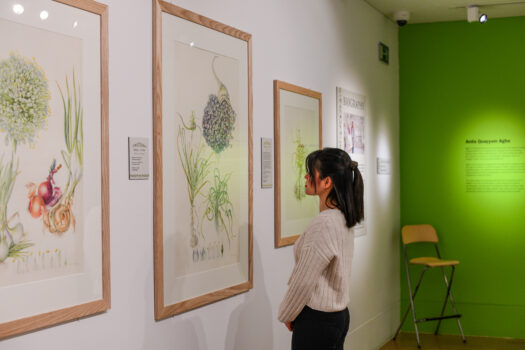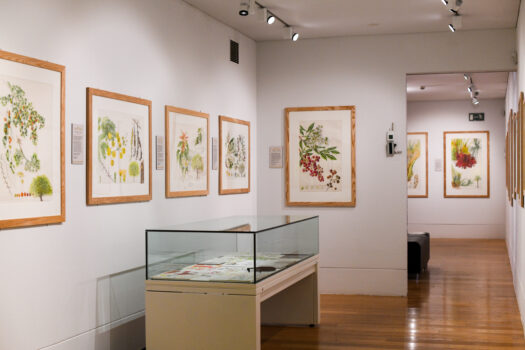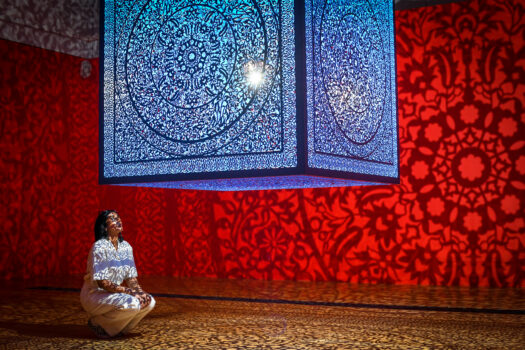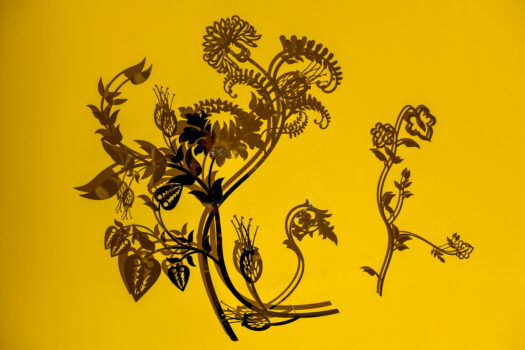The Shirley Sherwood Gallery of Botanical Art is a gallery that has been open since 2008 at Kew Gardens and is the world’s first display dedicated to solely Botanical Art. The gallery is currently showcasing in tandem two exhibitions, titled ‘Plants of the Qur’ān’ and ‘All the flowers are for me’ by renowned artists Sue Wickison and Anila Quayyum Agha respectively.
Even before we enter any of the gallery rooms, the hallway presents our first encounter with the paintings of Sue Wickison. Wickison is a New Zealand-based botanical Illustrator, with many of her works already part of the Shirley Sherwood collection. Plants of the Qur’ān is a six-year journey that finally culminated. This journey accounts for hundreds of hours painted to create each individual work in this series of 25 astonishingly detailed watercolour botanical paintings. This is a collaboration between artist Sue Wickison and Kew Scientist Dr. Shahina A. Ghazanfar which has found a kind of conclusion in this spectacular first-time public viewing of this series.

Plants of the Qur’an by Sue Wickison. (c) RBG Kew
The paintings are a provocation. A series that adventures from the earliest cultivator. The paintings give value to an encounter with an expansive trail, transitioning every stage from the tree, and its seedling, all the way to fruiting. The paintings are a narrative building, the lifecycle, transformation, and ripening are all in a singular frame but are never single-minded. Surveying plants across the Middle East, Wickison took on a roving location trail of Flora and Botanic from mountainous Oman to the farms of the United Arab Emirates. Working from living specimens, the colours are accounted for by pressings, all these plants are documented, and the lifespans are recorded to then be finalised and painted by her to every fine and exquisite detail.
A process visible is one that endeavours. At most times this is very much a solitary task, a loving laboured by sourcing first-hand encounters, and informed by extensive research. Thus, a metamorphosis grows into something new, into something seemingly previously unknown, but it finds its home in the scripture. A kind of telling. A re-telling. Each painting trails its own story, a detailed expression. This is very different from the geometric which is usually associated with Islamic art and architectural practices. The plants depicted, all of which are referenced in the Qur’ān, were cultivated for medicinal, a source of shade, food, and fragrance to name a few. Predominantly depicted in the Qur’ān are food plants, the series mirrors with illustrations of Tin [fig], Nakhl [date palm], Khardal [mustard], Rumman [pomegranate], Thom [garlic], and many, many more.

Plants of the Qur’an by Sue Wickison. (c) RBG Kew.
If more is desired, author Shahina A. Ghazanfar of the book Plants of Qur’ān: History and Culture, not only features Sue Wickison illustrations, but is also the first to hold such a comprehensive illustrated collection of Quranic plants. The plants are given their critical due diligence, with extensive investigative research backing cultural history, etymology, and wherein the Qur’ān they are mentioned.
All the Flowers Are for Me is a grand sculptural installation by a first-time exhibitor at Kew, Pakistani-American artist Anila Quayyum Agha. A steel and lacquer laser-cut box is suspended from the ceiling, with a light held within the sculpture to project shadows all around you. The work is lit from within, to go outward, to go towards you. The shadows follow you. The work encapsulates and takes hold of the entirety of the space, shadows paint floor to ceiling, lingering in every corner, with no surface daring to be left untouched. So much so anyone walking through and around the space becomes part of the art, part of the vision. This work is formed from a pattern that cannot be seen in its entirety anywhere in the world, only fragments of it can be seen repeated. The pattern is patched up from old historical buildings and pattern work, Islamic art, and architecture surveying old Iran, Turkey, and across South Asia. The pattern designed is the creation of the artist’s own aesthetic, their own being. Troubling the notion, that if you don’t see it, or see it not revered, – build it so it becomes more valuable. Nothing ever seems to stand alone.

All the Flowers Are for Me by Anila Quayyum Agha (c) RBG Kew.
The work lives for a space that occupies and is enamoured by so many homes across the world and now shares itself within this public space. The work takes hold within the traditions and references of Islamic art and architecture. A growing work that allows architecture to cool down and relight itself. Take from what is an offered abstraction, a refraction, – a reflection. A worlding, a civilisation, how it happens, – but how it happened nonetheless. If you say it is, it is yours, – layers of history, speak the language that nobody is alone that we truly all live for each other, – it is all but hopes for survival.
Accompanying All the Flowers Are for Me is the 2-piece work Stolen Moment Bouquet I and II, which premieres at Kew Gardens. This is a mirrored stainless steel flora wall-mounted piece, also laser-cut, matching up motifs from British textile designer William Morris and South Asian Islamic patterns. The work is made with the reflected shadow on the opposing wall and is lit from behind the wall piece itself. The work is made complete with you sharing the space with it.

Stolen Moment Bouquet by Anila Quayyum Agha. (c) RBG Kew
Anila Quayyum Agha and Sue Wickison’s works are situated perfectly at Kew Gardens. This is a soon-to-be-told-tale classic, an exhibition to be celebrated and revered. On view at the Sherwood Gallery of Botanical Art, until the 17th of September 2023.
Featured Image: All the Flowers Are for Me by Anila Quayyum Agha (c) RBG Kew.
Review by Devika Pararasasinghe
Devika is currently living and working in London, by trade an artist and snake oil salesperson. Devika graduated, last September with a research MFA at Ruskin School of Art, University of Oxford.
Devika’s latest review here Review: The Ugly Duchess: Beauty and Satire in the Renaissance- The National Gallery, until 11 June – Abundant Art
Footnote:
Maria Devaney, Galleries and Exhibition Leader at RBG Kew says :
“It’s wonderful to be able to welcome these two pioneering artists to the Shirley Sherwood Gallery of Botanical Art. Whist their working styles vary hugely in terms of technique, both share a profound connection to nature, recognising the breadth of inspiration which can be drawn from the world around us.”
Admission to the exhibition is included in a ticket to Kew Gardens. Pre-booking online offers the best value visit.
Gallery Six will feature an exhibition of works from the Shirley Sherwood Collection, celebrating water plants following the naming of Victoria boliviana as new to science in 2022.